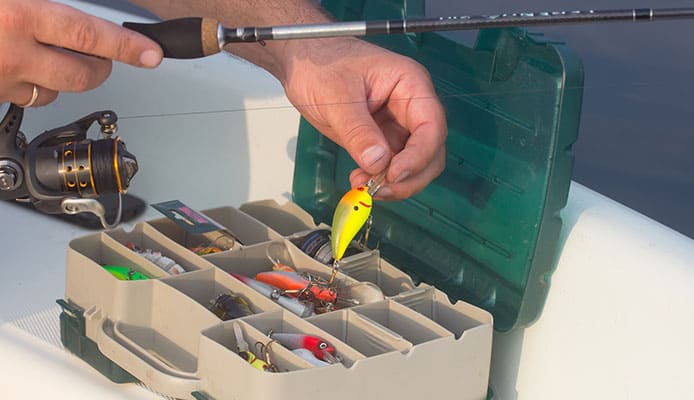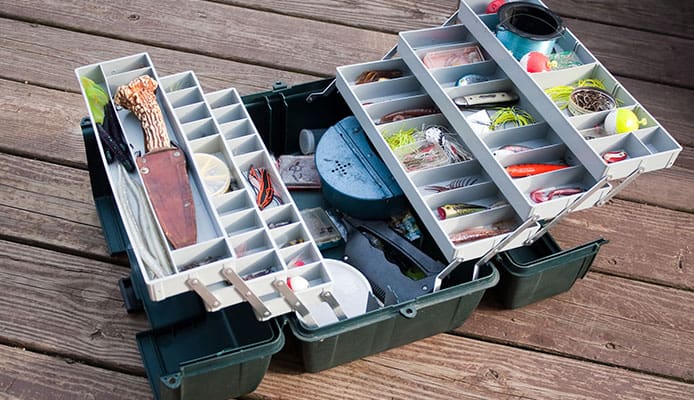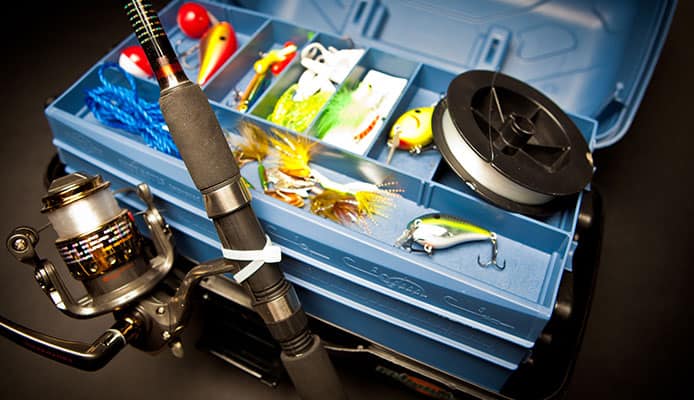
-
1.
-
2.
-
3.
-
4.
-
5.
Tackle boxes are the classic way to store, organize and transport fishing equipment and supplies. When you think of a fisherman’s gear storage, what comes to mind is a toolbox style hard plastic or metal box with a lock and top handle. Today, tackle boxes are very different from what they used to be in the past. There are hard plastic boxes but there are also soft-sided bags and backpacks.
They all look great, are more functional, have sophisticated organization systems and offer all kinds of storage options and features to make an angler’s life easier. Looking to acquire a tackle box for storing, organizing and transporting your fishing lures, baits, lines, hooks, sinkers, floats and other supplies and tools? Have a look at the top 10 best tackle boxes and bags reviewed below.
OUR TOP PICK
Plano 7771 Guide Series Tackle Box
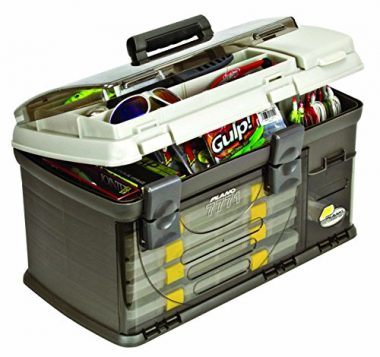
- What Makes This Box Stand Out
- A quality product backed by a limited lifetime warranty
- Very spacious with lots of room for all kinds of tackle and gear
- Has a nice tackle storage and organization system
EDITORS CHOICE
OkeeChobee Fats T1200 Bag Tackle Box
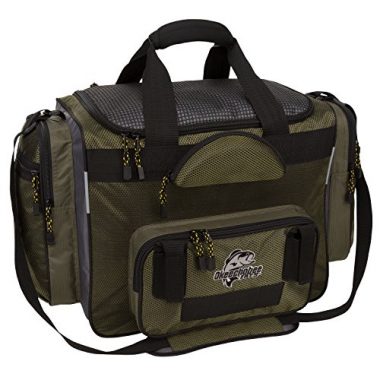
- What Makes This Box Stand Out
- Top notch quality
- Great customer service and a lifetime manufacturer’s warranty
- Amazing value for the money
- Plenty of storage and organization space
BEST VALUE
Spiderwire Wolf Bag Tackle Box
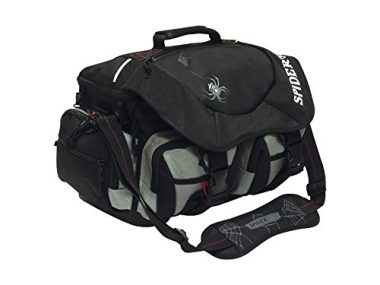
- What Makes This Box Stand Out
- Well-constructed and backed by a lifetime warranty from the manufacturer
- The compartments and pockets keep everything nicely organized and easy to access
- Very spacious with room for everything
- Comfortable to carry
Berkley Fishing Small Bag Tackle Box
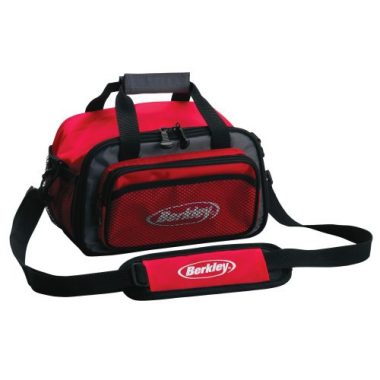
- What Makes This Box Stand Out
- Well made and good quality
- Compact and easy to carry
- Great storage and organization options
New Phase Large Fishing “Go To” Fly Tackle Box
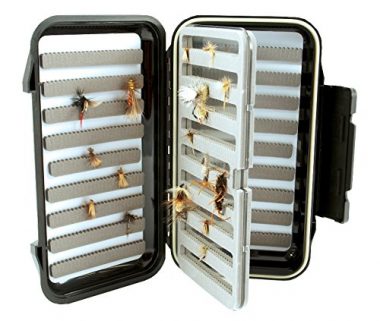
- What Makes This Box Stand Out
- Its capacity to hold a lot of flies
- Sturdy construction
- Durable and waterproof
YOGAYET Portable Outdoor Fishing Bag Tackle Box
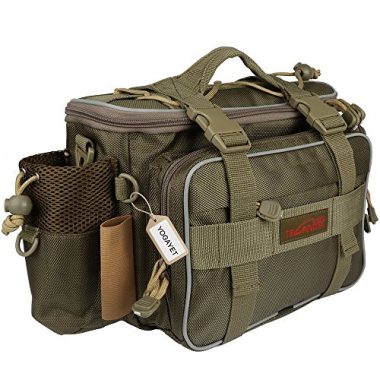
- What Makes This Box Stand Out
- Sturdy and durable
- Good design and great internal layout
- Excellent quality construction
- Reinforcing straps keep the content of the bag secured
Wild River by CLC Custom Leathercraft WT3702 Bag Tackle Box
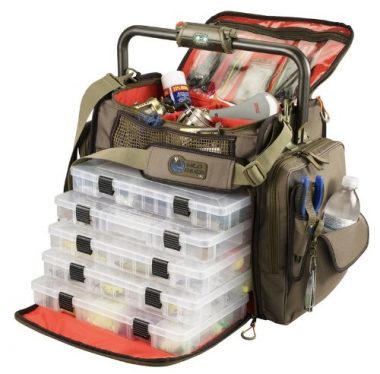
- What Makes This Box Stand Out
- It features a lighted handle
- Well made and compact
- Plenty of storage space
- Well thought out features
Elkton Outdoors Rolling Tackle Box
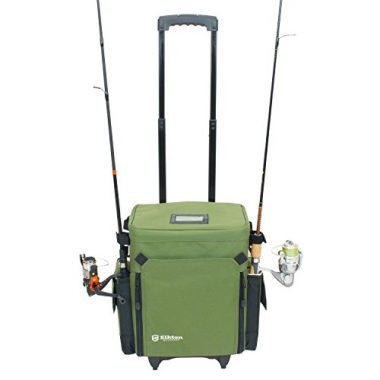
- What Makes This Box Stand Out
- The rolling feature makes transporting heavy fishing gear easy
- Very large storage capacity for all fishing gear
- Plenty of trays and compartments makes organizing your gear easy.
- Well made and excellent quality
- Great design and layout
Maurice Sporting Goods Fishing Bag Tackle Box
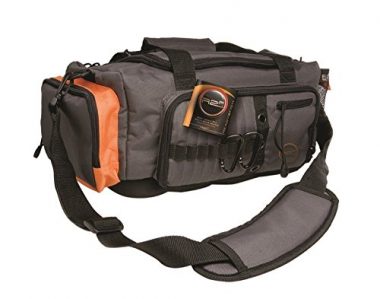
- What Makes This Box Stand Out
- It is easy and comfortable to carry
- Plenty of convenient features
- Great storage and organization capacity
- Affordable and great value
Custom Leathercraft Wild River CLC WT3505 Small Bag Tackle Box
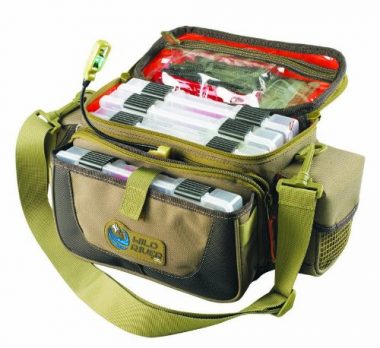
- What Makes This Box Stand Out
- The clip-on LED light is a nice extra
- Compact and easy to carry
- Well thought out design and built really well
- The bright orange interior is great for visibility
- It has amazing extras that add to its convenience
How To Choose The Best Tackle Box – Buying Guide
Tackle boxes are available in plenty out there. There are hard boxes, tackle bags and backpack tackle boxes with all kinds of features. Here are the factors to keep in mind as you select a tackle box to identify the one best suited to your fishing tackle storage needs and get good value for your money.
Size
Size is an important factor to consider when selecting a tackle box. You want a tackle box with enough storage and organization space for your supplies but that’s also easy to store and transport. There are small boxes to gigantic boxes with removable racks, trays, and drawers. Most of the tackle systems use standard sized utility boxes or trays that you can fit in different tackle systems.
If you’re an avid or multi-species angler who needs large lures and baits or needs to carry a wide array of tackle on a single trip, you’ll definitely need a big tackle box. If you’re looking for a one-stop tackle storage space, a big box will fulfill your needs you can fit all your fishing items in it.
If you don’t fish all that much and only need to have a small amount of lure and bait when you do, a small tackle box will be sufficient for your needs and with enough room to grow as you acquire more tackle and explore new fishing styles and types.
The ideal size to go for will also depend on how you get to your fishing spot. If you walk or hike, a tackle box can be cumbersome to carry and a smaller, lightweight tackle box, bag or backpack will be a better fit. If your destination is easy to access by car or boat, a large tackle box won’t be an issue.
Material
In the past, tackle boxes were primarily hard and made of metal or plastic. Today, they’re made from hard and soft materials. Each material has its pros and cons.
Hard tackle boxes are the traditional trunk style boxes that have a handle and clips for locking the box. They are usually made out of molded plastic, which is strong, better at resisting wear and durable.
Soft tackle bags and backpacks are made out of fabrics such as heavy-duty nylon or polyester. If you do fishing as a sport, tackles boxes made of soft materials such as backpacks or sling bags are ideal.
The bottom part should also be hard and waterproof to protect the box from dirt and wear and keep the content dry.
A good material is water resistant so it protects your lure, bait, and other supplies from water damage. It should also be tough enough to withstand exposure to rough terrain, weather conditions, and the occasional fall.
Space
You’ll also need to consider the amount space available and how it’ll help you organize your supplies and tools. A good one has sufficient space for your needs and enough trays and compartments to keep everything separate and neatly organized, easy to spot at a glance and easy to access.
The more baits and lures you need to carry such as when you’re an experienced or multi-species angler or going for an extended fishing vacation, the more space you need. If you fish only occasionally, are just getting started or going to fish for an afternoon, you don’t need all that space.
Hard tackle boxes usually have folding trays or sliding drawer style organization that makes it easy to store tackle separated, organized and therefore easy to spot and access. They usually also feature spaces on top for holding bigger items such as reels, spools, and tools.
Soft tackle boxes or tackle bags and backpacks feature adjustable inner compartments, multiple exterior pockets, removable trays and spaces and hoops for attaching accessories such as rods, making them adaptable and easy to organize.
Type
There are different types of tackle boxes and each has its advantages and disadvantages.
Hard Tackle Box
What comes to mind when most people think about tackle boxes are the trunk style boxes made out of plastic or metal and with a handle and clips for locking the box.
On the inside, most have cascading or folding trays or sliding drawer style organization that make it easy to store tackle separated, organized and therefore easy to access. They usually also feature spaces on top for holding items such as reels, spools, and tools. They’re best for shorter trips when you don’t need to carry a lot of gear or when you’re using a car or boat most of the way.
They’re inexpensive yet robust, durable and usually waterproof. They offer a lot of storage space and have lots of compartments for easy organization and make it easy to see the contents. They offer the best gear protection from water and the elements. Some even have worm-proof trays to prevent baits and lures or melting or sticking together.
The cons are that they can be heavy and cumbersome to carry and take a lot of storage space. In extremely cold or hot weather, plastic becomes brittle and breaks easily.
Soft Tackle bags
Soft tackle boxes or tackle bags are the most popular type of tackle box recently. Just like hard tackle boxes, they’re shaped like a box but made from soft, padded material such as nylon or polyester and with a handle and/or a shoulder strap for easy carrying.
On the inside, they usually have one or more main compartment that can be resized. They come with removable interior clear plastic utility boxes for organizing supplies. They’re best for organizing lots of small tackle.
Flexible inner compartments, multiple zippered pockets, removable trays and spaces for accessories such as rods and pliers make them adaptable and easy to organize. They’re lightweight and feature padded straps, handles and soft sided bodies that make them easier to carry. They also compact easily for storage.
The disadvantage is that they aren’t always waterproof, don’t let you see what’s inside the box without opening the bag and they don’t last as long as hard boxes.
Tackle Backpacks
This is the newest type of tackle box evolving from soft tackle bags. They’re designed to be carried on the back. They have all the advantages of soft tackle handbags and they’re also very spacious, ergonomically designed with padded shoulder straps, hip straps, and lumbar support to make carrying heavier loads on your person lighter and more comfortable.
They’re very convenient as they keep your tools and supplies easily accessible while leaving your hands free to navigate the trail or hold other things. You can even wear them as you fish.
Tackle fishing backpacks are ideal when you need to walk or hike to get to your fishing spot or any activity that requires the use of your hands. They’re also versatile as you can use them when hiking, cycling, traveling, hunting, mountaineering, rock climbing, and camping.
Durability
You want to end up with a tackle box that serves you for a long time giving you value for your money. Hard plastic boxes are the best for durability, as they’re robust, durable and usually waterproof. Soft tackle bags and backpacks usually aren’t completely waterproof and they don’t last as long as hard boxes.
Pay attention to the following factors to ensure you get a durable item.
For hard plastic boxes, choose a well-made box constructed using hardened/molded plastic which has better resistant to weathering, cracking, staining and isn’t susceptible to damage due to prolonged exposure to water. Ensure the hinges and handles are sturdy and operate smoothly. If protection from water exposure is especially important to you, ensure that the box is completely waterproof and that it doesn’t leak in water.
Pro Tip: Avoid exposing your plastic tackle boxes to extreme temperatures such as freezing weather or the hot sun. Over time, these make the plastic fragile and prone to cracking easily.
As for soft sided tackle bags and backpacks, choose one made from a durable, water-resistant fabric such as rip-stop nylon or heavy duty polyester. Look for one with heavy-duty zippers, reinforced seams, and quality double stitching, especially where the straps attach to the bag.
Storage
You’ll want to get a tackle box with enough room for the gear you’ll need while fishing. You’ll also want to ensure there’s plenty of storage options both on the inside and outside to make it easier to organize and easily access what you need.
Hard tackle boxes usually have cascading or folding trays or sliding drawer style organization for storing tackle separated, organized and easily accessible. They usually also feature spaces on top for holding larger items such as reels, spools, and tools.
Soft tackle boxes or tackle bags and backpacks feature customizable inner compartments, multiple pockets for small items, removable trays and exterior spaces for accessories such as rods making them adaptable and easy to organize.
Where you’ll store your tackle box when not in use or when you’re fishing is another important consideration. A large and heavy hard plastic box is rigid and requires a lot of storage space. On the other hand, soft sided tackle bags and backpacks are compact, soft sided and don’t require as much storage space.
FAQs
Q: What Type Of Tackle System Should I Buy?
The type of tackle system you should get will be determined by how you fish, where you fish and how you get to your fishing destination. If you fish from a boat a hard tackle box might be best for you. If you are fly fishing or river fishing from the bank, a backpack or sling pack will work best.
The right system will also be organized, helping you find exactly which lure you need at the time, and it should be easy to transport from storage to your car or boat then to your fishing spot and back. And it should withstand the terrain and conditions you fish in.
Hard tackle boxes are inexpensive yet robust, durable and mostly waterproof. They offer a lot of storage space and have lots of tray or drawer style compartments for easy organization. They offer the best gear protection.
Soft tackle bags have adaptable inner compartments, multiple pockets, removable trays and spaces for accessories such as rods. They’re lightweight and feature padded straps, handles and flexible bodies that make them easier to carry.
Tackle backpacks are spacious and ergonomically designed with padded shoulder straps, hip straps and lumbar support to make carrying heavier loads on your person more comfortable. They’re very convenient as they keep your gear easily accessible while leaving your hands free.
Q: How Should I Organize My Tackle Box?
There’s no right or wrong way to organize your tackle box. However, it’ll definitely make your life easier to organize supplies and lures for one type of fishing in one area for easy access and always put everything in the same place so you don’t have to look in every pocket for the item you need.
For tools you use often, you may find it better to organize them where you can easily access them preferably on storage spaces and hoops on the outside of your tackle box.
This is a matter of personal preference. What matters is that everything is organized, easy to find and access when you need it. With experience, you’ll discover your preferred way. You can experiment with different methods to tell how to best organize your lures and tackle for a great experience.
Q: What Should I Keep In My Tackle Box?
First of all, the fishing essential for all anglers: Bait and lures to attract the type of fish you go for, fishing line or cord, sinkers/weights that sink your lures into the water, bobbers that float, or bob, on the water until a fish bites, floats that keep your bait floating, rigs, a versatile needle nose fishing pliers, swivels, leaders, knife and spinners. Pack items specific to your type of fishing and type of fish.
Some other nice to have items include a flashlight, lighter, manual, small first aid kit, disinfectant wipes, and bug spray.
Don’t forget personal items such as shoes, gloves, sunscreen, fishing hat, sunglasses, a small towel, snacks, beverages as well as your fishing license and your electronic devices.
The much have content will depend on the type of fish you’re going after, your style of fishing, space your box offers, how you’ll be transporting it and also your personal preference.
If you have space and its easy to transport, you can take everything just in case or you can just pack what you’ll need for the day. Try not to pack stuff that you know you aren’t going to use to keep the load lighter. With experience, you’ll know the must-haves in your tackle box.
Q: Which Is Better, A Hard Or Soft-sided Tackle Box?
Hard tackle boxes are inexpensive yet robust, durable and usually waterproof. They offer a lot of storage space and have lots of tray or drawer style compartments for easy organization and easy visibility. They offer the best gear protection. The downside is that they can be heavy and cumbersome to carry and take a lot of storage space. Hard boxes are best for shorter trips, when you don’t need to carry a lot of gear or when you’re using a car or boat most of the way.
Soft tackle bags and backpacks feature divisible inner compartments, multiple pockets, removable trays and attachment spaces for accessories such as rods. These features make them adaptable and easy to organize. They’re lightweight and feature padded straps, handles and moldable construction that make them easier to carry. They also compact easily for storage.
Which is better for you will depend on your fishing style, the amount of tackle you need to carry and the conditions you fish in.
When fishing on your own boat, you don’t need to carry tackle on your person and can use either hard tackle boxes or tackle bags.
If you fish from the bank or need to hike to get to your fishing spot, a large hard tackle box would be difficult to carry and a fishing tackle backpack would be the ideal option as they load will be lighter on your back.
If you fish from your blow up kayak, you don’t have room for large tackle boxes or tackle backpacks and a compact soft sided tackle bag would be a great option.
You can have the best of both worlds by owning a hard tackle box as well as a soft side tackle shoulder bag or backpack. Ensure both have the capacity to accommodate the utility boxes you use.
Q: What Is Tackle?
Tackle is the general term used to refer to all of the equipment and supplies used to fish. The rod, reel, and line are the basics. There are also hooks, bait, lures, and supplies that you attach and use at the end of your fishing line. These are appropriately referred to as “terminal tackle”. A tackle box is the best way to keep these organized and easy to access when you need something.
Q: What Are The Essential Items Found In A Tackle Box?
The essential items to have in a tackle box include baits, lures, bobbers, rigs, floats or sinkers, lines, needle nose fishing pliers, hooks, swivels, and spinners.
For you, the essentials will also depend on the type of fish you catch. For example, the baits and lures most suited to the type of fish you catch will be a must-have.
Some tackle box systems come fully loaded tackle but you may find that you don’t need to use everything included or need supplies and tools not included.
You’ll also need other personal items such as sunglasses, drinks and bug spray.
Q: Should I Get A General Box Or Separate Boxes Designed For Different Types Of Fishing?
Currently, there are no specialty tackle boxes specifically customized for let’s say bass fishing, surf fishing or fly fishing. What there are are different types of boxes that suit different types of fishing better.
Rack style boxes with pull out trays are great for organization if your type of fishing requires a lot of lures. Tackle backpacks are great for fly or shore fishing where you may need to wear your tackle for easy access to supplies while leaving your hands free to catch the fish.
If you’re an avid or multi-species angler and like to try different types of fishing and explore different fishing locations, you may benefit from having both a hard plastic tackle box and a tackle backpack. Most of the tackle systems use utility boxes or trays universally sized so that you can fit in different tackle systems.
Globo Surf Overview
As a fishing enthusiast, you know that having the right gear easily accessible when you need it makes the whole experience that much more enjoyable. A tackle box system satisfies this basic fishing need. Whether you’re a deep sea angler, bass angler or a freshwater fisherman, you can benefit from having a tackle box.
Storing your hooks, sinkers, floats, lures and bait in a system that keeps everything separate, neatly organized and easy to see and access is a great way to maximize relaxation and enjoyment during a fishing trip.
Your tackle storage system can make or break your fishing day out, and that system starts with the quality of the box. To choose the best tackle box, ask yourself: How do I fish? What supplies and tools do I need to have with me? Where do I fish? How do I transport my fishing gear?
Then you’ll be able to choose your best tackle box out of the top rated tackle boxes and bags and end up with one that meets your need for storing and organizing fishing lures and supplies in a convenient and accessible way making you a happy and satisfied angler whenever you’re going after the fish. Happy fishing!
More Fishing Reviews:
- Catfish Reel
- pincast Reel
- Saltwater Fishing Rods
- Saltwater Spinning Reels
- Baitcasting Rod
- Bass Rod And Reel
- Fishing Backpack
- Smallmouth Bass Lures
- Flies For Trout
- Waders For Women
Do you use a tackle box system to transport and organize your fishing lures and supplies? What do you pack in it? Let us know all about it in the comments box below.



